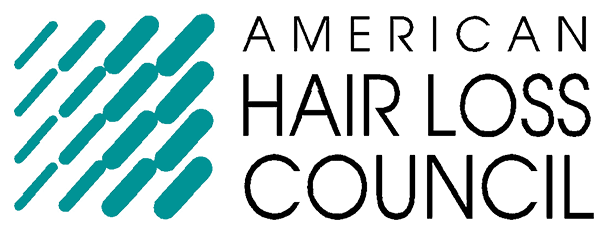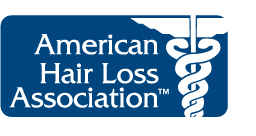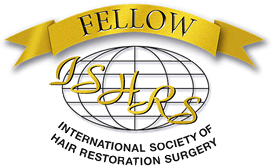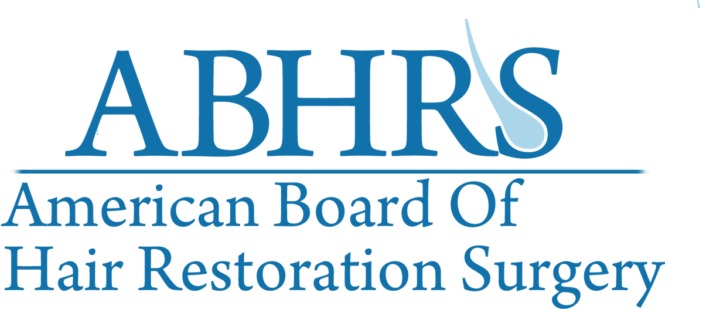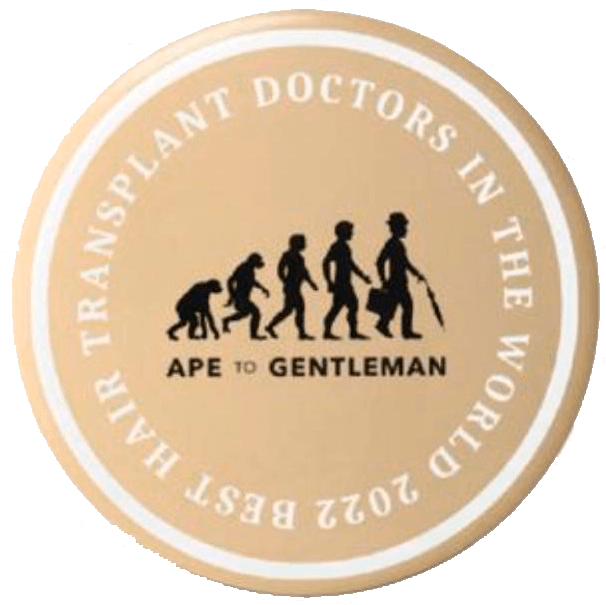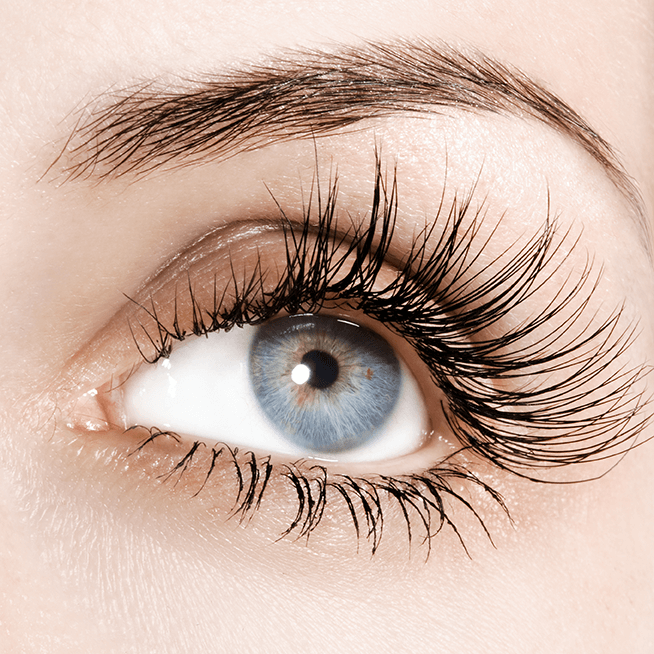Hair Loss Specialist Dr. Alan Bauman discusses “Biohacking Baldness” with Dallas McClain on the Biohackers Magazine Podcast at the Biohacking Congress in Miami, Florida
**TRANSCRIPT**
[music]
0:00:00.0 Dallas: Hi everyone. I’m Dallas McClain from Biohackers Magazine. We’re here at the Biohacking Congress in Miami, and we’re very fortunate to have many great guest speakers with us, over 30 guest speakers, over 20 products and companies with us that we’re learning a lot from. We encourage you to go to their website, biohackingcongress.com to learn about the upcoming congress in Las Vegas as well, March 19th to the 20th. We’re here with Dr. Alan Bauman, who is a specialist in hair restoration and many other different types of things with that area. And we’re very excited to learn more. Dr. Bauman, welcome.
0:00:38.3 Dr. Alan Bauman: Thanks, Dallas. Thanks for having me. It’s great to be here, it’s great to present and obviously be amongst many like-minded individuals and biohackers here. It’s been a great conference so far and continuing onward.
0:00:48.7 Dallas: Of course, we’re making great connections and learning a lot from everyone in all different types or areas. But we’re very excited to learn about your area, and particularly hair restoration and how you got your start in this area.
0:00:58.9 DB: Well, there’s a lot of myths and misconceptions about hair loss and hair restoration. Certainly, almost 30 years ago when I learned about hair loss and hair transplants, everybody thought that it was voodoo medicine, like snake oil treatments or that the procedures were pluggy and painful. And what I saw at that time really struck me completely different. So many people ask me, “Well, how did I get involved in the field of hair loss and hair transplants?” And I certainly never planned it that way. My first interest was in plastic surgery and cosmetic surgery, helping people look good and feel good by changing their appearance or restoring their appearance. But when I met a patient who had had a hair transplant, and I was unable to tell, and this was back in the mid-1990s, it blew me away. And I was struck by the naturalness of his hairline, which had been restored through surgery.
0:01:45.7 DB: And the other thing that stuck with me was how it changed his life. So I remember vividly him telling me about the changes in his life status, his career, his social situations, relationship status. All of these different things changed once he had restored his hair. So that combination of, “Hey, maybe there’s this surgical aspect of single follicle implantation, this artistry, but also this life-changing result on the backend, maybe I should pay attention to this.” And so I kind of started at that moment to pay attention and to follow that a little bit more strongly. Because as a plastic surgeon, you don’t really come across too many training opportunities in hair transplant surgery and I was lucky enough to find one.
0:02:26.5 Dallas: Very cool.
0:02:27.2 DB: And that was almost 30 years ago.
0:02:28.5 Dallas: Wow. So that was a little while ago then.
0:02:30.6 DB: Yeah.
0:02:31.0 Dallas: Since then, you’ve built on that foundation a little bit of what made that special. Building off of that question, what separates you from a lot of other different types of methods used out there, particularly in the field of treatment medicine for hair loss?
0:02:45.5 DB: So my practice is a bit of a unicorn, to be honest. I’m one of only 200 board-certified hair restoration physicians in the world. Proud to be listed as one of the top 20 clinics in the world. And we’ve been ranked number one by Aesthetic Everything for five years and running.
0:03:00.3 Dallas: Wow.
0:03:00.7 DB: So we have a 12,000 square-foot facility. Patients often ask, even people here at the conference ask, “Well, is all you do hair transplants?” Actually no. Out of the 1500 patients or so that come in every single year for treatments, we only operate about 200-300 of them. The rest of them are under medical management. What does that mean? That means that we’re treating their hair loss before it’s noticeable to the naked eye in many cases. So prevention, evaluation, therapeutic interventions that are non-chemical, non-invasive, to help them keep the existing hair, so that hopefully, maybe they don’t need as much transplantation or any transplantation in the future as they go along.
0:03:35.5 Dallas: That’s a good point. So we’re talking about the evaluation part because there’s a lot of signals that our body can give off, and our aura can give off, that maybe something down the line may happen with their hair, or to that effect. So, can you tell me a little bit more about all the different elements that make up those signals and those symptoms and what we need to look out for?
0:03:53.0 DB: Oh yeah, absolutely. So hair follicles are one of the most highly metabolic cell populations in your body. Probably close in terms of metabolic activity to your gut lining and your bone marrow, which kind of makes sense if, God forbid, you need chemotherapy treatment or cancer treatment, it knocks out those highly replicating cells. So that’s why people lose their hair when they’re undergoing that kind of cancer therapy or treatment, right? So, because hair follicles are so metabolically active, they’re a very, very strong barometer for your health. So, and evolutionarily, it kinda makes sense. If you have a thick, glowing full thick head of hair, you’ve got this sign of youth and vitality and health. Think of the plumage on a bird trying to attract a mate. So many people view their head of hair as a sign of youth and vitality, and friends of mine have said fertility as well.
0:04:41.8 DB: So when something is going wrong in your body, sometimes your hair is the first signal, if you will. So it could be shedding. You’re seeing more shedding in the drain, in the shower, in the brush, on the pillow. It could be that you’re receding, the hairline is changing, you’re seeing more scalp in different areas. You’re seeing less coverage in your scalp. It could be on top or towards the crown area. Maybe, for a woman, her ponytail volume is shrinking. Or maybe your hair quality has changed over time. What used to be thick and shiny and smooth hair, now is looking a little bit more dry, or becoming a little bit more frizzy, looking more damaged. So these are all signs and symptoms that something is going on with the hair follicle or the health of the scalp.
0:05:26.3 Dallas: So, going along with that and what you can do in terms of what power you have to recognize those symptoms and those signs and take control, how much of a role does genetics play into that? ‘Cause that’s what I think a lot of people might be wondering about.
0:05:39.8 DB: Yeah. So we used to say, “It’s the mother’s, father’s fault,” but that’s kind of an old wives’ tale. Well, maybe an old husband’s tale. But the point is that today we know that there are hundreds of genes and thousands of SNPs or single nucleotide polymorphisms that are related to hair and hair loss. So there’s a huge expression of hair loss that happens in the genetic code. So the speed at which you might lose your hair, the pattern, the color, the quality, the texture of your hair over time, and how much your hair is gonna be resilient or sensitive to different body functions such as hormone changes, nutrition, stress, all of that is genetically related now. And we actually have genetic tests. We’ve had genetic tests for over a decade to elucidate whether someone is at risk for male or female pattern hair loss. And now through pharmacogenetics, we can actually tell what treatments you’re likely to respond to by doing genetic testing. So yes, the short answer to that question is definitely the primary risk of male and female pattern hair loss, which is androgenetic alopecia, can come from the mother’s side or the father’s side. So if you’re opening that family album, you’re looking on Facebook and you see some aunts and uncles, grandparents, parents with some hair loss, that’s a risk factor, and so we need to take a look at it.
0:06:55.4 Dallas: I gotcha. So, looking less at the physical side of things and things that we can track, and genetics, and things that we do, and habits that we incorporate into our daily life, what about the mental aspect of hair loss? Because maybe like impotence and other things like that that we don’t necessarily think about, that are in the back of our minds subconsciously, maybe even while we asleep, or we’re not aware of it, do those have any kind of studies backing them that show it could be an effect to make you more likely to lose your hair?
0:07:21.5 DB: Well, so what we know about your mental state is that it can work both ways. If you’re having high stress situation, that can shut down the hair follicles, but on the good side, if you’re growing good hair, your quality of life completely changes. Like that gentleman that I met 30 years ago, when he had had his transplant, his life changed for the better. The hair flipped a switch to happiness for him. But when hair loss is occurring, your quality of life can go downhill pretty quick. You’ve heard of the bad hair day, well, if you have a hair loss or hair problem, or even a scalp health issue, that could turn into a bad hair week, month or life, that’s not so good.
0:07:57.5 Dallas: No, that’s not good at all.
0:07:58.2 DB: So, the interesting thing is, I was just having this conversation earlier that the hair follicle is a very psychologically-oriented organ. So, if you’re not doing so well in terms of stress management, that could be affecting your hair, but if your hair is doing well, man, you get a boost.
0:08:16.7 Dallas: Right, and it’s a positive feedback loop, right?
0:08:18.3 DB: Correct.
0:08:19.1 DB: You work on the mind, you work on the hair, they both work together.
0:08:21.5 DB: Absolutely, so if you just take some small steps, even if it’s just a diagnostic process to find out what’s going on with your hair, get your hair measured with a scalp microscope, for example, and we are doing that here at the conference today, that first step kinda gets rid of the boogeyman, like, “Okay, now I know what my status is.” It’s like tracking your sleep for the first week, you now know, “Hey, I didn’t get as much deep sleep as I want to, I’m not getting as much good quality sleep.” Let’s look at the quantity and quality of your hair, and let’s put that in specific, objective terms, not just, “Oh, I think my hair looks okay today.” Once you have an objective measurement, now we can take actionable steps to change weaker hairs to stronger hairs, lower density to higher density.
0:09:04.2 Dallas: So, going back to the myths that you were bringing up, and again, because I think there are a lot of myths and misconceptions out there, so just to clear one thing up, I don’t know if you notice, I’m starting to get a little bit of gray in here, and I’m only 30. Not only 30, I’m 30, I’m getting up there. And my dad had salt and pepper hair when he was about 35 or 40 or something like that. Is that more of a genetic thing that isn’t brought on as much by stress, or is that something that we should be more aware of, and could lead to potentially more of an effect of hair loss?
0:09:36.8 DB: So, I guess anecdotally, in the clinical literature, we’ve had examples of a shock or stress to the system, and then that patient loses pigmentation in their hair, sometimes permanently, sometimes temporarily. The research on gray hair is ongoing, so we don’t have all of these answers, but we do know that there’s a genetic tendency towards what I would call premature grey. So, guys in their 20s and 30s who are going gray might think that they’re premature, just the same way as if they’re losing their hair, they go, “Oh my God, I’m prematurely balding. This is not good either.” So there is a genetic tendency towards gray. I would say that the research is underway, so stay tuned. There’s no magical miracle reversal that we can accomplish at this moment, but we have some hints now in the clinical literature and some of the research that I’m personally involved with, with the University of Miami, about how to reverse the gray in follicles in a petri dish is… Eventually will be translated to the clinic, hopefully. We’ll see.
0:10:37.6 Dallas: That is very exciting.
0:10:38.7 DB: Yeah, yeah, so stay tuned on the gray hair fix. I don’t have that for you yet, but there are some pharmaceutical interventions that we are testing and trying in the practice. So, there are certain candidates that we choose for those kinds of tests in the office and we use something very safe and FDA-approved for that, but we can look and see how the gray hair is changing over time.
0:11:00.9 Dallas: That’s great.
0:11:01.4 DB: That’s not a primary thing that we do at Bauman Medical, but it is kind of exciting to be on the forefront of something that might be helpful to reverse the gray, which is obviously another unwanted sign of aging along with hair loss.
0:11:12.6 Dallas: Right. That’s a very intriguing concept, for sure. So looking more into the research and the studies and things that are going behind hair loss and restoration, are you guys able to look at the active areas of the brain that may be under more stress, or does that have any kind of correlation between what lobes of the brain might be under more stress or not functioning properly that could be leading to more hair loss in a specific area? Or is that a little too…
0:11:36.2 DB: Yeah, I would say that we don’t have the research on that yet. I will tell you that the quickest way to shut down a hair follicle in a petri dish is cortisol.
0:11:44.3 Dallas: Cortisol.
0:11:45.1 DB: So, if you’ve got cortisol in the petri dish, that follicle shuts down pretty quick. So we know that the follicles are sensitive to spikes in stress, and spikes obviously in cortisol or hormones. So the normal cortisol should spike in the early morning, early part of the day, and then should taper off as the day ends, but if you’ve got this prolonged cortisol exposure, you could be shutting down these hairs prematurely. Now, there’s no easy fix for that. Obviously, as a biohacker, we work on mindfulness and meditation, and breathing exercises to negate and to decrease that cortisol response and to try to improve all of our bio-signals in that way, and to arrange our brain so that we’re not as affected by the stress. Because the stress is not just knocking your hair out, let’s face it. It’s cancer, heart disease, stroke, everything that you could possibly touch in the body is probably detrimentally affected by stress, so let’s get a handle on that, right?
0:12:39.1 Dallas: Right.
0:12:39.4 DB: We spend a lot of time talking about stress in the practice. How do we sleep better, get more deep sleep, get better quality sleep? So, what’s interesting is my practice has turned a lot and learned a lot from the biohacking sphere, and there’s been a lot of integration of those things. So many more patients this year will come in wearing Oura Rings than ever before. Maybe it’s not just having done Dave Asprey’s hair transplant, but just being around the field of biohacking, which, as we were saying before, we used to just be called anti-aging physicians or health gurus and things like that, and now we’re biohackers. So, that’s how it evolves. [chuckle]
0:13:18.0 Dallas: Yeah, yeah, the terms are always evolving with what we’re doing in our everyday lives. So, going back to what you were talking about with your practice, where you don’t necessarily look first thing towards helping the hair and the hair restoration, you look more towards almost preventative measures that we can do to help the hair and keep the hair nourished, what are some of those things?
0:13:37.5 DB: In my presentation, one of the first things that you see on the treatment strategy list is risk reduction, so whether it’s the stress or your nutritional status or maybe medications that you’re on. It could be things that you’re doing to try to improve your health, like hormone optimization that could be detrimental to your hair, so we wanna try to identify those habits. Maybe it’s the way that you’re styling your hair, so for women using a lot of heat or a lot of chemicals repeatedly, we know that that can get into the scalp and disrupt the hair follicle function, not just make the hair look a little bit more rough and dry and cause breakage, but literally get into the skin and hurt the hair follicle over time.
0:14:17.0 Dallas: That’s very interesting. I don’t think a lot of people think necessarily about that.
0:14:19.9 DB: Yeah. Like for example, if a woman is thinning, she may resort to hair extensions, and hair extensions make you look beautiful, you know, think Britney Spears, she’s got like this Hollywood head of hair, right? But also Britney Spears at some point got a little concerned about her hair situation and ended up shaving her head. So that’s probably not a good hair hero to have on your side. We definitely want to try to intervene before you get to that point, so I guess my point is, is that if you’re gonna use hair extensions, let’s try to work out what’s gonna have the least amount of detrimental impact to your scalp and the hair follicles. So lighter extensions, more equally distributed, rotate them around, maybe they’re not so long and not so heavy, how are we attaching them to the scalp and things like that. So we teach a lot of hairstylists and a lot of hair extension, hair replacement professionals what to do to help their clients with thinning hair, protect their hair and not overdo it.
0:15:15.4 Dallas: Right. So you start more or less with less invasive, more natural methods first before heading down the lines of maybe eventual surgery?
0:15:23.6 DB: Correct. So we’re gonna start with what are the right nutritional supplements that are specific to their situation and their hair situation, and then we could go into if we’re talking about non-chemical therapies, we can use red light therapy, you know. Twenty years ago, nobody heard of red light therapy for anything, really.
0:15:39.4 Dallas: Right.
0:15:40.3 DB: Today, everybody’s on it. So we use, for example, the TURBO LaserCap, which is a device that we can prescribe and dispense for patients. It’s safe, it’s non chemical, it’s got a high energy output, it’s not… Never, ever gonna hurt you. Five-minute treatment time, just goes over the top of your scalp at night before bed, five minutes on and off, and that’s it. And that’s gonna dramatically improve the health of the hair follicles in those areas, really the frontal area all the way through to the nape of the neck, and FDA cleared for hair regrowth, it’s a great unit.
0:16:11.2 Dallas: Can you talk about… More how that works scientifically, how it activates the hair follicles?
0:16:15.2 DB: Absolutely. So if you had asked me that question 25 years ago, when I got my first laser, it was like this huge $100,000 machine and all these big clunky things going down on the scalp, we had no idea how red light therapy affected the skin, and I honestly didn’t even think it was gonna grow any hair. I was a big skeptic, but we tried it and we learned that you had to do it a certain amount of time, a certain exposure of red light therapy to the skin, and you had to do it repeatedly in order to get the result. So today we know… My photobiomodulation mentor is Dr. Michael Hamblin, he’s probably the most well-published researcher in the world on red light therapy and the use of low-level lasers or photobiomodulation and how it impacts animal cells.
0:17:00.4 DB: And so what he’s taught me is that red light is absorbed by the mitochondria and the mitochondria increase their ion concentration across the membrane, and as those ions rotate back, flow back through the membrane, you get ATP production and a huge cascade of other things happen. So ATP is the energy that the cells use, remember we talked about hair follicles being highly metabolic, so if we can increase that energy production and push those cells into a growing phase an anagen phase for the hair follicle, man, we’re gonna get a thicker, stronger, healthier hair. Non-chemical, non-invasively.
0:17:35.4 Dallas: Right. That is so cool. Yeah.
0:17:37.3 DB: Red light therapy is awesome. And we use it for healing after a hair transplant as well.
0:17:41.1 Dallas: Wow. So talk a little bit more about… You said there’s effects afterwards when people are starting to get their confidence back, their hair back and everything, how it affects and leeches out to other areas of their lives, and you see all these positive effects and lifestyle changes. Can you tell me a little bit more about that?
0:17:55.2 DB: Oh, yeah. I mean, one of the most exciting things about running a practice where we see patients day in and day out who have had procedures and treatments, and it doesn’t matter whether they’ve had a hair transplant or stem cell therapy, like a PRP or PDOgro, or these other types of technologies, or even just starting on a compounded pharmaceutical that’s specifically tailored for them, or just altering their lifestyle in the right direction and getting better hair growth from that, man, it’s a huge boost to their self-esteem, self-confidence when their hair is looking good. When their hair is looking good, they look in the mirror, they see better hair growth, they feel good, and it permeates all aspects. Their personality changes, it could change their professional outlook, it could change their social status and social interactions, whether it be out there on the dating scene, like some guys are, you now, midlife, whatever, recently divorced, they wanna change their life and get back into it, kind of turn the page on the next chapter, or they’re just on a health kick now, they just… Look, we all come to an age where we’ve gotta decide whether we’re gonna go down fighting or not, and sometimes hair is part of that fight.
0:19:02.0 Dallas: Of course.
0:19:02.5 DB: Yeah. I like my hair, I wanna keep my hair. That’s why I’ve been fighting for 20 years.
0:19:05.4 Dallas: Right. That’s what you were born with, that’s what you wanna have, that’s what you wanna go out with.
0:19:07.7 DB: Exactly, exactly.
0:19:08.7 Dallas: Yeah. That makes total sense. So talking about… You said the effects on your character, your personality and everything like that. That could also maybe tie back to hormones, like you were mentioning before, does looking at yourself in the mirror with a full head of hair and seeing that confidence and everything and going out to tackle the world, could that also have like a positive correlative effect with dopamine production or testosterone production or anything like that?
0:19:33.1 DB: Well, I think the issue with hormone production is the following, we know the trigger for male pattern hair loss is DHT, dihydrotestosterone. So testosterone gets converted into DHT, that’s the metabolite, and there’s an enzyme that converts testosterone to DHT, and what you’re born with, if you have male pattern hair loss or even some women with androgenetic alopecia, is that sensitivity to DHT, so follicles in their frontal hairline and in the crown, and maybe even across the entire top of the scalp can be sensitive to DHT.
0:20:03.4 DB: So when you’re young and your testosterone is up high, you could have accelerated hair loss, around that time when you’re in your 20s and 30s. As you enter into your 40s or 50s, your testosterone level may decrease a little bit, and with that, DHT levels. So your hair loss can slow down slightly. Most of the guys that I know in the biohacking sphere are trying to optimize their hormones, so when you increase that exogenous testosterone, whether you’re doing an injection or a pellet or something like that, more of that testosterone is converted into DHT, and that could hurt your hair. So we have to be very careful with hormone optimization. And very often my patients that come in who are replacing testosterone, are noticing a little bit more hair loss. So we gotta fight back. We’ve gotta make those follicles a little more resilient, maybe we dial back on the testosterone a little bit, maybe we put up some kind of a blockade, an anti-androgen that’s not gonna create any side effects, something that we use topically on the scalp, for example, to help protect those follicles over time. So I think that’s the take-home message when it comes to hormones and hair loss in the anti-aging world and hormone replacement world, for sure.
0:21:05.3 Dallas: That makes total sense. Thank you for explaining that.
0:21:07.3 DB: Yeah.
0:21:07.3 Dallas: So I wanted to get a little bit more into the personal side of you.
0:21:10.4 DB: Okay.
0:21:10.7 Dallas: If I may, Dr. Bauman.
0:21:11.8 DB: Yeah, for sure.
0:21:12.4 Dallas: So because you’re seen as the leader and you run a clinic, and for all these people and you’re just seen as a visionary for the industry and everything, talking about keeping yourself healthy so that you can be the optimal self, to go out there and do what you need to do, because we gotta take care of ourselves in order to be of service to others, right?
0:21:30.6 DB: For sure.
0:21:31.1 Dallas: So what do you do in your daily lifestyle that helps keep you functioning at an optimal level?
0:21:37.6 DB: Yeah, my energy level is critically important. Obviously, I expend a lot of energy. Many of our days are 12-hour days, for sure, whether it’s surgery, meeting with patients, and then I wanna be… I wanna be a great husband, I wanna be a great father to my boys, and all of that, and so having a good amount of energy and to be low stress and all of that is a critical goal for me. And I found that, from my internship and residency program over 30 years ago, that I was a little bit deficient in sleep. I have never been a good sleeper since that time. As a surgical resident, we only worked about 140 hours a week, so there wasn’t that much time for sleep, on-call and such.
0:22:16.3 Dallas: Oh, wow.
0:22:16.6 DB: I tell… Always tell the story where I would sleep… If I did get a chance at off-time, during the on-call schedule to even get back to the on-call room, I would tape the beeper to my head, so I wouldn’t miss a call.
0:22:29.5 Dallas: Oh my goodness.
0:22:29.9 DB: And so, I say, post-traumatic-sleep disorder, I don’t know if that’s a thing, but I feel like I’m… Ever since that time, I’ve gotten up early and stayed up late. And much to my… Probably to my detriment. So one of the first things that I tried to figure out with the help of other biohackers and people like Dr. Matthew Walker, Why We Sleep author, great information there, I wanted to improve, if I couldn’t get more quantity of sleep, I wanted to improve the quality of my sleep. And so, probably the most important wearable that I have is my Oura Ring. It helps me track over time how things are going in terms of my deep sleep, my recovery status. So I know how much I can expend at the gym, whether I disrupted something with an extra glass of wine on a Friday night or something, or too big of a meal after dark. I know exactly how it’s going to affect me, and things that have helped me sleep better, just personally, like weighted blankets didn’t help, but temperature control did. So I’m a huge fan of ChiliSleep, OOLER saved my life, saved my marriage…
[chuckle]
0:23:34.2 DB: Improved my deep sleep dramatically. Simple stuff like blue-blocking, obviously during the day, and then especially after dark, so to limit my exposure to blue light from my laptops and my phones. Try to turn off the TV, or if I can’t turn off the TV ’cause my wife loves to watch the news, right before bed, I don’t know how she does it… And she sleeps great.
0:23:54.8 Dallas: Oh, wow.
0:23:55.8 DB: So me, not so much. So I got my Red Goggles on, I mean the aliens could be landing and I’m like, “Okay, honey, I’ll see you in the morning.” And I just turn over, go to sleep with my Twilights on. So that’s probably my favorite thing to do is to try to get more… Better quality sleep, if I can. So I’m really tracking that.
0:24:14.8 Dallas: Well, sleep is definitely one of the most important things, I think that puts our body into that rest-recovery state.
0:24:20.6 DB: Yeah. Sleep is the Swiss Army knife of wellness.
0:24:23.4 Dallas: Yep. There you go.
0:24:24.8 DB: So, we have to good sleep to be optimized. I think that’s a critical, critical step.
0:24:29.8 Dallas: I completely agree.
0:24:30.7 DB: Yeah.
0:24:31.0 Dallas: So, getting a little bit more specific…
0:24:32.6 DB: Yeah.
0:24:32.6 Dallas: Can you take me through what you do on a daily basis, besides just the sleep, that help you to function at a clear and persistent level?
0:24:42.3 DB: Yeah, yeah, for sure. So I’m on an 18/6 time-limited feeding window.
0:24:49.4 Dallas: Fasting.
0:24:49.8 DB: Yeah. People call it intermittent fasting. It’s really “time-limited feeding” because I’ve compressed the time window to six hours. Sometimes I’ll just have a snack at 2:00 PM and then a dinner later on. Sometimes I’ll even just bypass the snack and just do one meal a day. That’s pretty much my five-day workweek. On the weekends, I wouldn’t say it’s like a cheat day, because I still try to eat well and clean, but I don’t really focus on a fasting schedule over the weekend. If the family wants to go out for brunch, I’m in.
0:25:14.6 Dallas: Yeah, I’m the same.
0:25:15.4 DB: And I’m bit of a foodie. So time-limited feeding, it seems to work best for me. I also, over the course… Before the pandemic, I was doing quarterly five-day fasts, water fasts. Now I do monthly three-day fasts, water fasts. So, that’s helped me enormously, I think between the caffeine, which is of course… I use butter coffee just about every day, and then the time-limited feeding or intermittent fasting schedule has really improved my mood, it’s improved my motivation, it’s improved my energy level, I also lost probably almost 20 pounds.
0:25:49.4 Dallas: Oh, wow.
0:25:49.7 DB: This was about five years ago or so, and I feel great. I’m really, really happy with my energy level at this time. So I think between the sleep and the fasting, it’s really been good. Now, of course, I do all the other stuff too. So I got the Hapbee Band, I got the Apollo Neuro. I’ve got a couple other tricks up my sleeve. I’ve been doing the BrainTap as much as I possibly can.
0:26:11.0 Dallas: Yeah.
0:26:11.5 DB: I’m not such a great meditator. I’ll be honest. I’ve tried so many times to get into that routine. But the BrainTap seems to be able to work with me in terms of my schedule as kind of a focused… And let’s face it, I’m a little bit of a gadget guy, so the BrainTap seems to work for me, to push me into that meditative state, and that’s been super helpful too.
0:26:31.7 Dallas: Good deal. So going back a little bit to the fasting that you were talking about with the water and everything, it sounds almost like a cleanse to get some of the toxins out maybe as well, because you’re just ingesting water and you’re not necessarily putting all that fuel in your body, just the water, and I don’t know if you do it with lemons or some people do it with cayenne pepper. There’s all these different types out there, but how important is it to get those toxins out of the body in terms of hair health, for example.
0:26:58.4 DB: Well, for hair regrowth, you could have toxin build-up for sure, and there could be chronic conditions that could detrimentally impact the hair. I don’t know that there’s any studies that show a relationship between fasting and hair growth, but I will bet that there is gonna be more and more information now about autophagy, and especially mitochondrial autophagy, mitophagy and hair regrowth, and I think that’s something we should definitely continue to take a look at. I think we’ll see more of that bench work happening now. And then on to the… Translate that into the clinic and see if we can really make that hair rebound and regrow.
0:27:31.5 DB: I don’t think it too much of as a cleanse, honestly, I’m into more of the autophagy process. So it’s kind of like cleaning out, recycling those older cells, senescent cells that are just kinda hanging around, maybe not being also optimized and your body is recycling that material and reusing it, or getting rid of those cells. So, that’s kind of my goal with the fasting process, and I always use electrolytes. I’ve made every mistake. [chuckle] I’ve broken a fast with a cheeseburger. I’ve done it all wrong. And I guess that’s the life of a biohacker, to be honest. I’ve done water fasts without electrolytes, and let me tell you, you pee out a lot of water. I lost 12 pounds in a five-day water fast one time, and gained back six in a day. So what was that? That was water, that was water. This was way back before Dave wrote the book on fasting. I’m like, “Wow, wish I had this manual before we got started with this stuff.”
0:28:24.3 Dallas: I know.
0:28:26.0 DB: But we live and we learn, and so hopefully we can pass along that knowledge. Obviously, Fast This Way is a great book and a good starting point for someone who wants to kinda take control of that eating window, and see if they can break that cycle. I don’t wanna be tied to my urge to eat exactly at 12 noon like my grandmother. Everywhere we were at 12 noon, it didn’t matter if we were at the mall or in Disney or wherever, at 12 noon, we had to stop for lunch. Well, I don’t wanna be a slave to that kind of… I don’t wanna be mentally shackled like that. So I think that’s what intermittent fasting, kinda dissociates that hunger cycle. Even if it’s time-limited feeding, or if you can do fasting-mimicking diets like Valter Longo’s research shows, and of course, I don’t know if you’ve heard of… What’s the name of the fasting mimicking diet? ProLon is one of the things that I started with. Those are basically small do-it-yourself meals during mealtime that have very low caloric intake. And so that’s one way to get started on a fasting kind of regimen. And once you do that and you realize that the food tastes terrible, then you can just go to regular water fast, and then you’re, boom, off and running.
0:29:35.2 Dallas: There you go.
0:29:36.0 DB: So that’s how I got my start with it, and it’s been great. To me, it’s life-changing.
0:29:39.8 Dallas: Oh, yeah, I love fasting. I usually do a 16/8 fast and I notice the difference. I do cheat on the weekends though, I have to admit.
0:29:45.8 DB: Yeah, well, no, you can’t be a 100% this or that. You have to be metabolically flexible, so yeah, maybe we eat more butter and oil during the week, but then on the weekends, we introduce some carbs, and I think, we’ve learned that you can’t be like a 100% Keto a 100% of the time, and it’s just… You’re gonna hit a wall at some point.
0:30:03.0 Dallas: Right, burnout, exactly.
0:30:04.4 DB: For sure. So you gotta re-introduce that stuff.
0:30:06.5 Dallas: Right. So staying on the future, topic of future for hair restoration, hair health and bringing this to the forefront of health practitioners and talking about it with your clinic, how does your clinic see the future of this content matter, this hair health, and how do you get behind that mission of moving it forward?
0:30:26.0 DB: So I have an interesting perspective, because I really was born into the world of hair transplant surgery, doing a strip harvest procedure. So we take a big strip of skin and we sewed it shut with stitches or staples, chopped it up under a microscope and put the grafts in. Today, based on the technology that we have, that I helped pioneer over 10, 15 years ago, we now do minimally invasive hair transplant. So it’s no scalpel, no stitches. It’s not gonna be pluggy, it’s not gonna be painful, I have unique control over every individual hair follicle that we’re gonna implant, and there’s no linear scar in the donor zone. We can harvest hair follicles from the scalp. If you’re depleted there, we can hardest follicles from the beard or the body and place those on the scalp as well. So there is a lot of new technology that’s come out in that realm.
0:31:10.8 DB: I’ve also seen the acceleration of regenerative medicine. So back 15 years ago, we started with PRP procedures. We were basically using a test tube and a salad spinner. It was pretty basic, but it was the first FDA-approved PRP treatment for wound care, and we used it to help heal our patients after hair transplant surgery, but we realized that if you inject it, inject it properly, and then create the PRP correctly, you could get a dramatic boost of hair growth, and if you combine that with a biological or surgical scaffold, or synthetic scaffold, I should say, you can get a boost of hair growth that lasts for a year. So now, regenerative technology, a lunchtime-type procedure without transplantation, get the existing hair to boost up and grow stronger for a period of time. So that’s been super exciting.
0:31:58.4 DB: And so if the people ask, “Well, hey, what’s next? What’s coming?” Everybody wants to know is hair cloning coming around? Are we gonna get an unlimited supply of hair follicles for implantation? And what they say if you’re a stem cell researcher, they always say, another five years, and I’ve been hearing that for 20 years. So, am I a little skeptical that we’ll have it in five years? Maybe. But I do know that the research is accelerating now. We have more regenerative technology, like exosome therapy, things like that, that we never had even thought of, stem cell therapy without the cells and so forth. But I have some good friends in Southern California, in San Diego, who are working on induced pluripotential stem cells to recreate an unlimited supply of dermal papillas, which are the basis of the hair root, essentially, with fibroblasts to make up the rest of the follicle, so that hopefully, eventually, we can have an unlimited supply of hair. So it’s super exciting technology. They got it to work in a mouse.
0:32:55.4 Dallas: Wow.
0:32:55.8 DB: They’ve got some money to make it happen in a pig. Stay tuned, if they can do it in a pig, then maybe we’ll start some human trials, but those are my good friends at Stemson over there, Alexey Terskikh and Geoff Hamilton, those are great guys, and so keep an eye on them and we’ll see what’s happening.
0:33:12.5 Dallas: That sounds very groundbreaking.
0:33:14.1 DB: Yeah, pretty exciting stuff.
0:33:15.4 Dallas: Yeah, I think we’re all gonna be excited to follow that and your journey as well with the clinic. We’re very happy to have you here at the Biohacking Congress, and it’s been an absolute pleasure, doctor.
0:33:26.6 DB: Well, thank you so much.
0:33:27.5 Dallas: I hope to talk again soon. Would you like to give a last message and check out…
0:33:31.2 DB: Yeah, we’ve certainly answered a lot of questions during the presentation about hair loss and hair restoration and really how to protect, enhance and restore your own living and growing hair, and I know that there are a lot of people out there who struggle with this and maybe searching for answers online or from friends or family or even physicians out there. But if you have a question about hair loss and you wanna chat with me about it, the best way to do that, the best way for us to connect is at baumanmedical.com. Just click on baumanmedical.com, request a consultation. If you just have a simple question, you can do baumanmedical.com/ask. It will bring you right up with a Q&A, you can ask a question right in there and I’ll respond.
0:34:06.5 DB: Great, thank you Dr. Bauman. Dallas McClain, Biohackers Magazine, here from the Biohacking Congress, wishing everyone a great rest of your day. Take care.
[music]
If you or someone you know has hair loss, hair thinning, baldness, or eyebrow / eyelash concerns, click to start either a long-distance virtual consultation OR an in-person, in-office consultation with Dr. Bauman. You can also Ask Dr. Bauman a Question or simply call Bauman Medical Group at +1-
*Each individual's treatment and/or results may vary



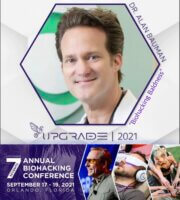 Dr Alan Bauman will be a featured speaker at the 7th Annual Biohacking Conference in Orlando
Dr Alan Bauman will be a featured speaker at the 7th Annual Biohacking Conference in Orlando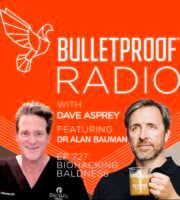 Dr. Alan Bauman reveals Dave Asprey’s “upgraded hair” after his Bulletproof Radio podcast on Biohacking Baldness
Dr. Alan Bauman reveals Dave Asprey’s “upgraded hair” after his Bulletproof Radio podcast on Biohacking Baldness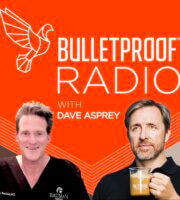 Dr. Alan Bauman sits down with Dave Asprey on Bulletproof Radio to discuss “Biohacking Baldness”
Dr. Alan Bauman sits down with Dave Asprey on Bulletproof Radio to discuss “Biohacking Baldness”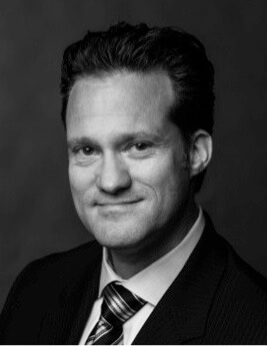 Dr. Alan J. Bauman, M.D.Hair Loss & Hair Transplant ExpertBoca Raton, FL
Dr. Alan J. Bauman, M.D.Hair Loss & Hair Transplant ExpertBoca Raton, FL